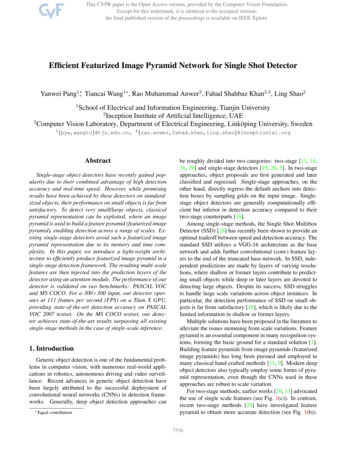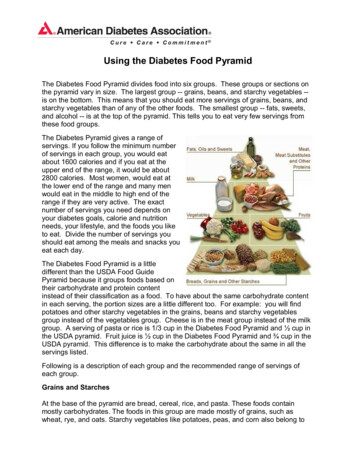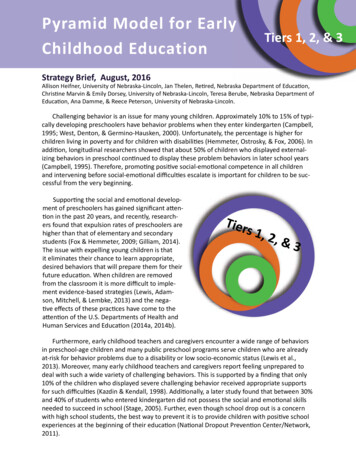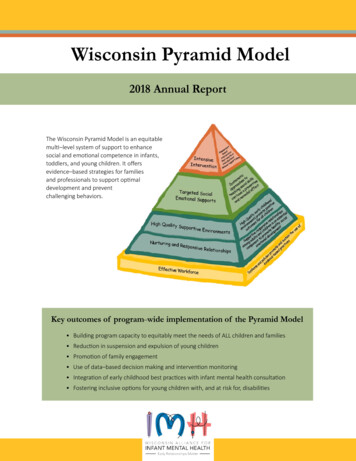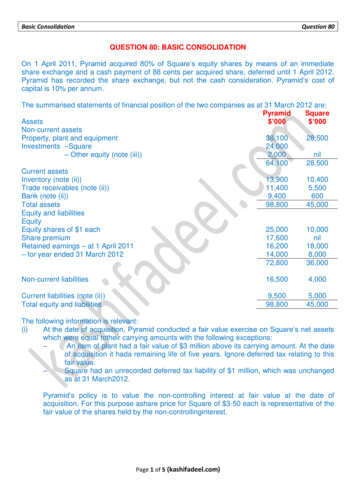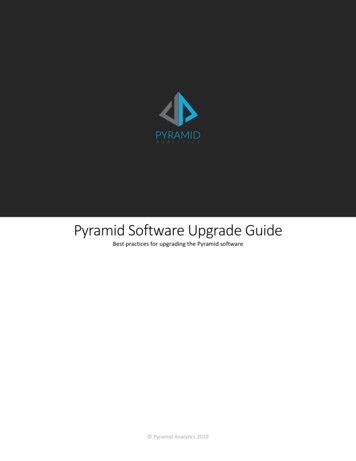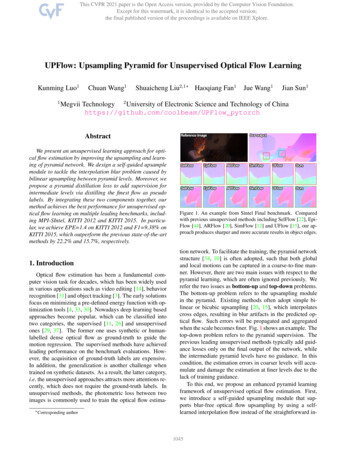
Transcription
UPFlow: Upsampling Pyramid for Unsupervised Optical Flow LearningKunming Luo11Chuan Wang1Shuaicheng Liu2,1 Haoqiang Fan1Jue Wang1Jian Sun1Megvii Technology 2 University of Electronic Science and Technology of Chinahttps://github.com/coolbeam/UPFlow pytorchAbstractWe present an unsupervised learning approach for optical flow estimation by improving the upsampling and learning of pyramid network. We design a self-guided upsamplemodule to tackle the interpolation blur problem caused bybilinear upsampling between pyramid levels. Moreover, wepropose a pyramid distillation loss to add supervision forintermediate levels via distilling the finest flow as pseudolabels. By integrating these two components together, ourmethod achieves the best performance for unsupervised optical flow learning on multiple leading benchmarks, including MPI-SIntel, KITTI 2012 and KITTI 2015. In particular, we achieve EPE 1.4 on KITTI 2012 and F1 9.38% onKITTI 2015, which outperform the previous state-of-the-artmethods by 22.2% and 15.7%, respectively.1. IntroductionOptical flow estimation has been a fundamental computer vision task for decades, which has been widely usedin various applications such as video editing [14], behaviorrecognition [31] and object tracking [3]. The early solutionsfocus on minimizing a pre-defined energy function with optimization tools [4, 33, 30]. Nowadays deep learning basedapproaches become popular, which can be classified intotwo categories, the supervised [11, 26] and unsupervisedones [29, 37]. The former one uses synthetic or humanlabelled dense optical flow as ground-truth to guide themotion regression. The supervised methods have achievedleading performance on the benchmark evaluations. However, the acquisition of ground-truth labels are expensive.In addition, the generalization is another challenge whentrained on synthetic datasets. As a result, the latter category,i.e. the unsupervised approaches attracts more attentions recently, which does not require the ground-truth labels. Inunsupervised methods, the photometric loss between twoimages is commonly used to train the optical flow estima CorrespondingauthorFigure 1. An example from Sintel Final benchmark. Comparedwith previous unsupervised methods including SelFlow [22], EpiFlow [44], ARFlow [20], SimFlow [12] and UFlow [15], our approach produces sharper and more accurate results in object edges.tion network. To facilitate the training, the pyramid networkstructure [34, 10] is often adopted, such that both globaland local motions can be captured in a coarse-to-fine manner. However, there are two main issues with respect to thepyramid learning, which are often ignored previously. Werefer the two issues as bottom-up and top-down problems.The bottom-up problem refers to the upsampling modulein the pyramid. Existing methods often adopt simple bilinear or bicubic upsampling [20, 15], which interpolatescross edges, resulting in blur artifacts in the predicted optical flow. Such errors will be propagated and aggregatedwhen the scale becomes finer. Fig. 1 shows an example. Thetop-down problem refers to the pyramid supervision. Theprevious leading unsupervised methods typically add guidance losses only on the final output of the network, whilethe intermediate pyramid levels have no guidance. In thiscondition, the estimation errors in coarser levels will accumulate and damage the estimation at finer levels due to thelack of training guidance.To this end, we propose an enhanced pyramid learningframework of unsupervised optical flow estimation. First,we introduce a self-guided upsampling module that supports blur-free optical flow upsampling by using a selflearned interpolation flow instead of the straightforward in-1045
terpolations. Second, we design a new loss named pyramiddistillation loss that supports explicitly learning of the intermediate pyramid levels by taking the finest output flow aspseudo labels. To sum up, our main contributions include: We propose a self-guided upsampling module totackle the interpolation problem in the pyramid network, which can generate the sharp motion edges. We propose a pyramid distillation loss to enable robust supervision for unsupervised learning of coarsepyramid levels. We achieve superior performance over the state-of-theart unsupervised methods with a relatively large margin, validated on multiple leading benchmarks.2. Related Work2.1. Supervised Deep Optical FlowSupervised methods require annotated flow ground-truthto train the network [2, 43, 39, 40]. FlowNet [6] was thefirst work that proposed to learn optical flow estimation bytraining fully convolutional networks on synthetic datasetFlyingChairs. Then, FlowNet2 [11] proposed to iterativelystack multiple networks for the improvement. To cover thechallenging scene with large displacements, SpyNet [26]built a spatial pyramid network to estimate optical flow in acoarse-to-fine manner. PWC-Net [34] and LiteFlowNet [9]proposed to build efficient and lightweight networks bywarping feature and calculating cost volume at each pyramid level. IRR-PWC [10] proposed to design pyramid network by an iterative residual refinement scheme. Recently,RAFT [35] proposed to estimate flow fileds by 4D correlation volume and recurrent network, yielding state-of-the-artperformance. In this paper, we work in unsupervised settingwhere no ground-truth labels are required.2.2. Unsupervised Deep Optical FlowUnsupervised methods do not need annotations for training [1, 42], which can be divided into two categories: theocclusion handling methods and the alignment learningmethods. The occlusion handling methods mainly focus onexcluding the impact of the occlusion regions that cannotbe aligned inherently. For this purpose, many methods areproposed, including the occlusion-aware losses by forwardbackward occlusion checking [24] and range-map occlusionchecking [37], the data distillation methods [21, 22, 28],and augmentation regularization loss [20]. On the otherhand, the alignment learning methods are mainly developed to improve optical flow learning under multiple image alignment constrains, including the census transformconstrain [29], multi-frame formulation [13], epipolar constrain [44], depth constrains [27, 45, 41, 19] and featuresimilarity constrain [12]. Recently, UFlow [15] achievedthe state-of-the-art performance on multiple benchmarks bysystematically analyzing and integrating multiple unsupervised components into a unified framework. In this paper,we propose to improve optical flow learning with our improved pyramid structure.2.3. Image Guided Optical Flow UpsamplingA series of methods have been developed to upsampleimages, depths or optical flows by using the guidance information extracted from high resolution images. The earlyworks such as joint bilateral upsampling [16] and guidedimage filtering [8] proposed to produce upsampled resultsby filters extracted from the guidance images. Recentworks [18, 38, 32] proposed to use deep trainable CNNs toextract guidance feature or guidance filter for upsampling.In this paper, we build an efficient and lightweight selfguided upsampling module to extract interpolation flow andinterpolation mask for optical flow upsampling. By inserting this module into a deep pyramid network, high qualityresults can be obtained.3. Algorithm3.1. Pyramid Structure in Optical Flow EstimationOptical flow estimation can be formulated as:Vf H(θ, It , It 1 ),(1)where It and It 1 denote the input images, H is the estimation model with parameter θ, and Vf is the forward flowfield that represents the movement of each pixel in It towards its corresponding pixel in It 1 .The flow estimation model H is commonly designed as apyramid structure, such as the classical PWC-Net [34]. Thepipeline of our network is illustrated in Fig. 2. The networkcan be divided into two stages: pyramid encoding and pyramid decoding. In the first stage, we extract feature pairsin different scales from the input images by convolutionallayers. In the second stage, we use a decoder module Dand an upsample module S to estimate optical flows in acoarse-to-fine manner. The structure of the decoder module D is the same as in UFlow [15], which contains feature warping, cost volume construction by correlation layer,cost volume normalization, and flow decoding by fully convolutional layers. Similar to recent works [10, 15], we alsomake the parameters of D and S shared across all the pyramid levels. In summary, the pyramid decoding stage can beformulated as follows:iV̂fi 1 S (Fti , Ft 1, Vfi 1 ),iVfi D(Fti , Ft 1, V̂fi 1 ),(2)(3)where i {0, 1, ., N } is the index of each pyramid leveland the smaller number represents the coarser level, Fti and1046
Pyramid EncodingconvDSDSDSDSDSDSDecoder Module:Upsample Module:Pyramid DecodingFigure 2. Illustration of the pipeline of our network, which contains two stage: pyramid encoding to extract feature pairs in different scalesand pyramid decoding to estimate optical flow in each scale. Note that the parameters of the decoder module and the upsample module areshared across all the pyramid levels.BilinearupsamplewarpBilinear InterpolationInterpolation flowFigure 3. Illustration of bilinear upsampling (left) and the idea ofour self-guided upsampling (right). Red and blue dots are motionvectors from different objects. Bilinear upsampling often producescross-edge interpolation. We propose to first interpolate a flowvector in other position without crossing edge and then bring it tothe desired position by our learned interpolation flow.warpDense BlockFusioniare features extracted from It and It 1 at the i-th level,Ft 1and V̂fi 1 is the upsampled flow of the i 1 level. In practice, considering the accuracy and efficiency, N is usuallyset to 4 [10, 34]. The final optical flow result is obtainedby directly upsampling the output of the last pyramid level.Particularly, in Eq. 2, the bilinear interpolation is commonlyused to upsample flow fields in previous methods [10, 15],which may yield noisy or ambiguity results at object boundaries. In this paper, we present a self-guided upsample module to tackle this problem as detailed in Sec. 3.2.3.2. Self-guided Upsample ModuleIn Fig. 3 left, the case of bilinear interpolation is illustrated. We show 4 dots which represent 4 flow vectors,belonging to two motion sources, marked as red and blue,respectively. The missing regions are then bilinear interpolated with no semantic guidance. Thus, a mixed interpolation result is generated at the red motion area, resultingin cross-edge interpolation. In order to alleviate this problem, we propose a self-guided upsample module (SGU) toFigure 4. Illustration of our self-guided upsample module. We firstupscale the input low resolution flow Vfi 1 by bilinear upsamplingand use a dense block to compute an interpolation flow Ufi and aninterpolation map Bfi . Then we generate the high resolution flowby warping and fusion.change the interpolation source points by an interpolationflow. The main idea of our SGU is shown in Fig. 3 right.We first interpolate a point by its enclosing red motions andthen bring the result to the target place with the learned interpolation flow (Fig. 3, green arrow). As a result, the mixedinterpolation problem can be avoided.In our design, to keep the interpolation in plat areas frombeing changed and make the interpolation flow only appliedon motion boundary areas, we learn a per-pixel weight mapto indicate where the interpolation flow should be disabled.Thus, the upsampling process of our SGU is a weighted1047
Figure 5. Visual example of our self-guided upsample module (SGU) on MPI-Sintel Final dataset. Results of bilinear method and our SGUare shown. The zoom-in patches are also shown on the right of each sample for better comparison.combination of the bilinear upsampled flow and a modifiedflow obtained by warping the upsampled flow with the interpolation flow. The detailed structure of our SGU moduleis shown in Fig. 4. Given a low resolution flow Vfi 1 fromi 1the i 1-th level, we first generate an initial flow V f inhigher resolution by bilinear interpolation:Xi 1V f (p) w(p/s, k)Vfi 1 (k),(4)k N (p/s)where p is a pixel coordinate in higher resolution, s is thescale magnification, N denotes the four neighbour pixels,and w(p/s, k) is the bilinear interpolation weights. Then,we compute an interpolation flow Ufi from features Fti andi 1iFt 1to change the interpolation of V fVefi 1 (p) Xby warping:i 1w(d, k)V f (k),i 1 (1 Bfi ) Vefi ,In our framework, we use several losses to train the pyramid network: the unsupervised optical flow losses for thefinal output flow and the pyramid distillation loss for theintermediate flows at different pyramid levels.3.3.1(6)i 1where Vefi 1 is the result of warping V f by the interpolation flow Ufi . Since the interpolation blur only occurs inobject edge regions, it is unnecessary to learn interpolationflow in flat regions. We thus use an interpolation map Bfi toexplicitly force the model to learn interpolation flow only inmotion boundary regions. The final upsample result is thei 1fusion of Vefi 1 and V f :V̂fi 1 Bfi V f3.3. Loss Guidance at Pyramid Levels(5)k N (d)d p Ufi (p),use the first two channels of the tensor map as the interpolation flow and use the last channel to form the interpolation map through a sigmoid layer. Note that, no supervision is introduced for the learning of interpolation flowand interpolation map. Fig. 5 shows an example from MPISintel Final dataset, where our SGU produces cleaner andsharper results at object boundaries compared with the bilinear method. Interestingly, the self-learned interpolationmap is nearly to be an edge map and the interpolation flowis also focused on object edge regions.(7)where V̂fi 1 is the output of our self-guided upsample module and is the element-wise multiplier.To produce the interpolation flow Ufi and the interpolation map Bfi , we use a dense block with 5 convolutionallayers. Specifically, we concatenate the feature map Ftiiand the warped feature map Ft 1as the input of the denseblock. The kernel number of each convolutional layer inthe dense block is 32, 32, 32, 16, 8 respectively. The output of the dense block is a tensor map with 3 channels. WeUnsupervised Optical Flow LossTo learn the flow estimation model H in unsupervised setting, we use the photometric loss Lm based on the brightness constancy assumption that the same objects in It andIt 1 must have similar intensities. However, some regionsmay be occluded by moving objects, so that their corresponding regions do not exist in another image. Since thephotometric loss can not work in these regions, we only addLm on the non-occluded regions. The photometric loss canbe formulated as follows: P ΨI(p) Ip V(p)· Mt (p)tt 1fpP, (8)Lm p M1 (p)where Mt is the occlusion mask and Ψ is the robust penaltyfunction [21]: Ψ(x) ( x ǫ)q with q, ǫ being 0.4and 0.01. In the occlusion mask Mt , which is estimatedby forward-backward checking [24], 1 represents the nonoccluded pixels in It and 0 for those are occluded.To improve the performance, some previously effectiveunsupervised components are also added, including smoothloss [37] Ls , census loss [24] Lc , augmentation regularization loss [20] La , and boundary dilated warping loss [23]1048
(a) Visual comparison on KITTI 2012 (first two rows) and KITTI 2015 (last two rows).(b) Visual comparison on Sintel Clean (first two rows) and Sintel Final (last two rows).Figure 6. Visual comparison of our method with the state-of-the-art method UFlow [15] on KITTI (a) and Sintel (b) benchmarks. The errormaps visualized by the benchmark websites are shown in the last two columns with obvious difference regions marked by yellow boxes.Lb . For simplicity, we omit these components. Please refer to previous works for details. The capability of thesecomponents will be discussed in Sec. 4.3.3.3.2influence of these noise regions in the pseudo label, we alsodownsample the occlusion mask Mt and exclude occlusionregions from Ld . Thus, our pyramid distillation loss can beformulated as follow:Pyramid Distillation LossTo learn intermediate flow for each pyramid level, we propose to distillate the finest output flow to the intermediateones by our pyramid distillation loss Ld . Intuitively, thisis equivalent to calculating all the unsupervised losses oneach of the intermediate outputs. However, the photometricconsistency measurement is not accurate enough for opticalflow learning at low resolutions [15]. As a result, it is inappropriate to enforce unsupervised losses at intermediatelevels, especially at the lower pyramid levels. Therefore,we propose to use the finest output flow as pseudo labelsand add supervised losses instead of unsupervised losses forintermediate outputs.To calculate Ld , we directly downsample the final outputflow and evaluate its difference with the intermediate flows.Since occlusion regions are excluded from Lm , flow estimation in occlusion regions is noisy. In order to eliminate theLd N XXi 0p Ψ Vfi S (si , Vf ) · S (si , Mt ),(9)where si is the scale magnification of pyramid level i andS is the downsampling function.Eventually, our training loss L is formulated as follows:L Lm λd Ld λs Ls λc Lc λa La λb Lb , (10)where λd , λs , λc , λa and λb are hyper-parameters and weset λd 0.01, λs 0.05, λc 1, λa 0.5 and λb 1.4. Experimental Results4.1. Dataset and Implementation DetailsWe conduct experiments on three datasets: MPISintel [5], KITTI 2012 [7] and KITTI 2015 [25]. We use1049
UnsupervisedSupervisedMethodKITTI 2012KITTI 2015Sintel CleanSintel Finaltraintesttraintest (F1-all)traintesttraintestFlowNetS [6]FlowNetS ft [6]SpyNet [26]SpyNet ft [26]LiteFlowNet [9]LiteFlowNet ft [9]PWC-Net [34]PWC-Net ft [34]IRR-PWC ft [10]RAFT [35]RAFT-ft 134.58–3.39BackToBasic [42]DSTFlow [29]UnFlow [24]OAFlow [37]Back2Future [13]NLFlow [36]DDFlow [21]EpiFlow [44]SelFlow [22]STFlow [36]ARFlow [20]SimFlow [12]UFlow 896.926.505.32Table 1. Comparison with previous methods. We use the average EPE error (the lower the better) as evaluation metric for all the datasetsexcept on KITTI 2015 benchmark test, where the F1 measurement (the lower the better) is used. Missing entries ‘ ’ indicates that theresult is not reported in the compared paper, and (·) indicates that the testing images are used during unsupervised training. The bestunsupervised results are marked in red and the second best are in blue. Note that, for results of the supervised methods, ‘ ft’ means themodel is trained on the target domain, otherwise, the model is trained on synthetic datasets such as Flying Chairs [6] and Flying Chairsocc [10]. For unsupervised methods, we report the performance of the model trained using images from target domain.the same dataset setting as previous unsupervised methods [20, 15]. For MPI-Sintel dataset, which contains1, 041 training image pairs rendered in two different passes(‘Clean’ and ‘Final’), we use all the training images fromboth ‘Clean’ and ‘Final’ to train our model. For KITTI 2012and 2015 datasets, we pretrain our model using 28, 058 image pairs from the KITTI raw dataset and then finetuneour model on the multi-view extension dataset. The flowground-truth is only used for validation.We implement our method with PyTorch, and complete the training in 1000k iterations with batch size of 4.The total number of parameters of our model is 3.49M,in which the proposed self-guided upsample module has0.14M trainable parameters. Moreover, the running timeof our full model is 0.05s for a Sintel image pair with resolution 436 1024. The standard average endpoint error(EPE) and the percentage of erroneous pixels (F1) are usedas the evaluation metric of optical flow estimation.4.2. Comparison with Existing MethodsWe compare our method with existing supervised andunsupervised methods on leading optical flow benchmarks.Quantitative results are shown in Table 1, where our methodoutperforms all the previous unsupervised methods on allthe datasets. In Table 1, we mark the best results by red andthe second best by blue in unsupervised methods.Comparison with Unsupervised Methods. On KITTI2012 online evaluation, our method achieves EPE 1.4,which improves the EPE 1.8 of the previous best methodARFlow [20] by 22.2%. Moreover, on KITTI 2015 online evaluation, our method reduces the F1-all value of11.13% in UFlow [15] to 9.38% with 15.7% improvement.1050
CL!!!!!!BDWL ARL!!!!!!!!!SGU!!KITTI 2012PDL!!KITTI 2015Sintel CleanSintel 10.70)(10.28)(10.38)(9.91)Table 2. Ablation study of the unsupervised components. CL: census loss [24], BDWL: boundary dilated warping loss [23], ARL: augmentation regularization loss [20], SGU: self-guided upsampling, PDL: pyramid distillation loss. The best results are marked in bold.On the test benchmark of MPI-Sintel dataset, we achieveEPE 4.68 on the ‘Clean’ pass and EPE 5.32 on the ‘Final’pass, both outperforming all the previous methods. Somequalitative comparison results are shown in Fig. 6, whereour method produces more accurate results than the stateof-the-art method UFlow [15].Comparison with Supervised Methods.As shown inTable 1, representative supervised methods are also reported for comparison. In practical applications where flowground-truth is not available, the supervised methods canonly train models using synthetic datasets. In contrast, unsupervised methods can be directly implemented using images from the target domain. As a result, on KITTI andSintel Final datasets, our method outperforms all the supervised methods trained on synthetic datasets, especially inreal scenarios such as the KITTI 2015 dataset.As for the in-domain ability, our method is also comparable with supervised methods. Interestingly, on KITTI2012 and 2015 datasets, our method achieve EPE 1.4 andF1 9.38%, which outperforms classical supervised methods such as PWC-Net [34] and LiteFlowNet [9].4.3. Ablation StudyTo analyze the capability and design of each individualcomponent, we conduct extensive ablation experiments onthe train set of KITTI and MPI-Sintel datasets followingthe setting in[22, 12]. The EPE error over all pixels (ALL),non-occluded pixels (NOC) and occluded pixels (OCC) arereported for quantitative comparisons.Unsupervised Components.Several unsupervisedcomponents are used in our framework including census loss [24] (CL), boundary dilated warping loss [23](BDWL), augmentation regularization loss [20] (ARL), ourproposed self-guided upsampling (SGU) and pyramid distillation loss (PDL). We assess the effect of these components in Table. 2. In the first row of Table. 2, we only usephotometric loss and smooth loss to train the pyramid network with our SGU disabled. Comparing the first four rowsin Table. 2, we can see that by combining CL, BDWL andMethodBilinearJBU [16]GF [8]DJF [17]DGF [38]PAC [32]SGU-FMSGU-MSGUKITTI 2012KITTI 2015Sintel CleanSintel 3.20)(3.05)(2.95)(2.91)(2.86)(2.63)Table 3. Comparison of our SGU with different upsampling methods: the basic bilinear upsampling, image guided upsamplingmethods including JBU [16], GF [8], DJF [17], DGF [38] andPAC [32], and the variants of SGU such as SGU-FM, where theinterpolation flow and weight map are both removed, and SGUM, where the only the interpolation map is removed.ARL, the performance of optical flow estimation can be improved, which is equivalent to the current best performancereported in UFlow [15]. Comparing the last four rows in Table. 2, we can see that: (1) the EPE error can be reduced byusing our SGU to solve the bottom-up interpolation problem; (2) the top-down supervision information by our PDLcan also improve the performance; (3) the performance canbe further improved by combining the SGU and PDL.Some qualitative comparison results are shown in Fig. 7,where ‘Full’ represents our full method, ‘W/O SGU’ meansthe SGU module of our network is disabled and ‘W/O PDL’means the PDL is not considered during training. Comparing with our full method, the boundary of the predictedflow becomes blurry when SGU is removed while the errorincreases when PDL is removed.Self-guided Upsample Module. There is a set of methods that use image information to guide the upsamplingprocess, e.g., JBU [16], GF [8], DJF [17], DGF [38] andPAC [32]. We implement them into our pyramid networkand train with the same loss function for comparisons. Theaverage EPE errors of the validation sets are reported in Table. 3. As a result, our SGU is superior to the image guidedupsampling methods. The reason lies in two folds: (1) theguidance information that directly extracted from images1051
Figure 7. Visual results of removing the SGU or PDL from our full method on Sintel Clean (the first sample) and Sintel Final (the secondsampe). The room in flows and error maps are shown in the right corner of each sample.Sintel Clean trainMethodw/o PLPUL-upPUL-downPDL w/o occPDLSintel Final train 1 4 8 16 32 64 1 4 8 16 32 (7.16)(6.39)Table 4. Comparison of different pyramid losses: no pyramid loss (w/o PL), pyramid unsupervised loss by upsampling intermediate flowsto image resolution to compute unsupervised objective functions (PUL-up) and by downsampling images to the intermediate resolution(PUL-down), our pyramid distillation loss without masking out occlusion regions (PDL w/o occ) and our pyramid distillation loss (PDL).All the intermediate output flows are evaluated on the train set of Sintel Clean and Final.may not be favorable to the unsupervised learning of optical flow especially for the error-prone occlusion regions; (2)our SGU can capture detail matching information by learning from the alignment features which are used to computeoptical flow by the decoder.In the last three rows of Table. 3, we also compare ourSGU with its variants: (1) SGU-FM, where the interpolation flow and interpolation map are both removed so thatthe upsampled flow is directly produced by the dense blockwithout warping and fusion in Fig. 4; (2) SGU-M, wherethe interpolation map is disabled. Although the performance of SGU-FM is slightly better than the baseline bilinear method, it is poor than that of SGU-M, which demonstrates that using an interpolation flow to solve the interpolation blur is more effective than directly learning to predicta new optical flow. Moreover, the performance reduced asthe interpolation map is removed from SGU, which demonstrates the effectiveness of the interpolation map.Pyramid Distillation Loss. We compare our PDL withdifferent pyramid losses in Table. 4, where ‘w/o PL’ meansno pyramid loss is calculated, ‘PUL-up’ and ‘PUL-down’represent the pyramid unsupervised loss by upsampling intermediate flows to the image resolution and by downsamling the images to the intermediate resolutions accordingly.‘PDL w/o occ’ means the occlusion masks on pyramid levels are disabled in our PDL. In ‘PUL-up’ and ‘PUL-down’,the photometric loss, smooth loss, census loss and boundary dilated warping loss are used for each pyramid level andtheir weights are tuned to our best in the experiments. Toeliminate variables, the occlusion masks used in ‘PUL-up’and ‘PUL-down’ are calculated by the same method as inour PDL. As a result, model trained by our pyramid distillation loss can generate better results on each pyramid levelthan by pyramid unsupervised losses. This is because ourpseudo labels can provide better supervision on low resolutions than unsupervised losses. Moreover, the error increased when the occlusion mask is disabled in our PDL,indicating that excluding the noisy occlusion regions canimprove the quality of the pseudo labels.5. ConclusionWe have proposed a novel framework for unsupervisedlearning of optical flow estimation by bottom-up and topdown optimize of the pyramid levels. For the interpolation problem in the bottom-up upsampling process of pyramid network, we proposed a self-guided upsample moduleto change the interpolation mechanism. For the top-downguidance of the pyramid network, we proposed a pyramiddistillation loss to improve the optical flow learning on intermediate levels of the network. Extensive experimentshave shown that our method can produce high-quality optical flow results, which outperform all the previous unsu
Pyramid Encoding D S D S D S D S D S conv Pyramid Decoding Figure 2. Illustration of the pipeline of our network, which contains two stage: pyramid encoding to extract feature pairs in different scales and pyramid decoding to estimate optical flow in each scale. Note that the parameters of the decoder module and the upsample module are

